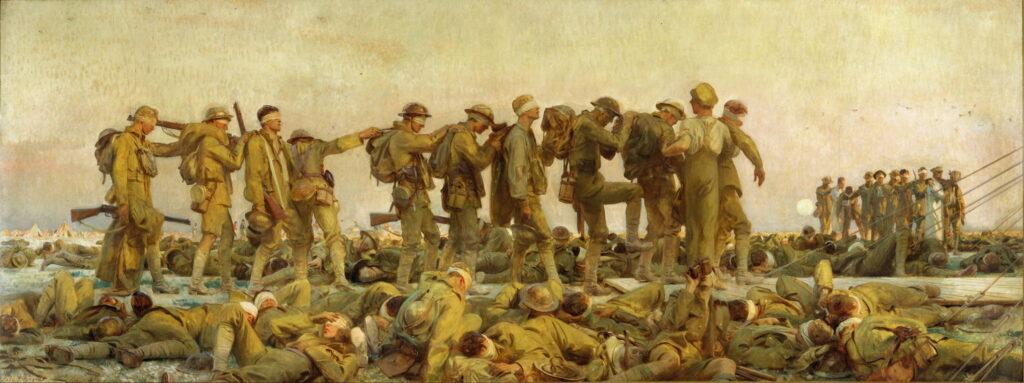Commemorating the centenary of John Singer Sargent’s death: 6 Post-war

A century ago today, on 14 April 1925, John Singer Sargent died in London. This last article celebrating his career and art resumes in the final months of the First World War, when Sargent had returned to Britain.
In 1918, John Singer Sargent was commissioned by the War Memorials Committee of the Ministry of Information in Britain to paint a large work showing Anglo-American co-operation in the war. This was originally destined for a Hall of Remembrance, which was never built, but required a very large if not monumental painting. He set off for the Western Front with Henry Tonks, a distinguished British artist and teacher, in July 1918, and they visited units near Arras and Ypres.
According to Tonks’ recollections recorded in a letter two years later, they both witnessed the result of a mustard gas attack during the opening of the Second Battle of the Somme on 21 August 1918 (although records suggest that may have been on 26 August). In the late afternoon, they heard that many casualties were arriving at a Corps dressing station at le Bac-du-Sud, so went there. Lines of gassed casualties were being led in, in parties of about half a dozen with a medical orderly in front. Apparently, Sargent was “struck by the scene and immediately made a lot of notes.”
This change to his commission required the approval of the War Memorials Committee, which he obtained before he started work on the painting in his studio in Fulham, London, in late 1918. I don’t know exactly when Sargent made each of the pencil sketches for his painting, but some may have been made near Arras, while others were clearly based on the professional models who he employed in his studio.
John Singer Sargent (1856–1925), Study for Gassed Soldiers (1918), charcoal and graphite on cream wove paper laid down on card, 47 × 61.6 cm, Yale Center for British Art, New Haven, CT. Wikimedia Commons.
Many, like Study for Gassed Soldiers (1918), show details of different passages for the final painting, and could have been made in Arras or Fulham.
John Singer Sargent (1856–1925), Study for ‘Gassed’ (1918), pencil on paper, 48.2 x 62.5 cm, The Imperial War Museum (Presented by the great-nieces and great-nephews of the artist, in memory of Miss Emily Sargent, 1987), London. By courtesy of The Imperial War Museums © IWM (Art.IWM ART LD 16162 9), http://www.iwm.org.uk/collections/item/object/23746
The most interesting, though, are his assemblies of figures, such as this Study for ‘Gassed’ (1918). This particular group was turned into the more distant line of casualties, at the right of the finished work.
John Singer Sargent (1856–1925), Gassed (detail) (1919), oil on canvas, 231 x 611.1 cm, The Imperial War Museum, London. Wikimedia Commons.
John Singer Sargent (1856–1925), Two Studies for “Gassed” (1918), graphite on paper, 64.5 × 93.5 cm, Fogg Art Museum, Harvard University, Cambridge, MA. Wikimedia Commons.
These Two Studies for “Gassed” (1918) in the Fogg Museum are more compositional in purpose, and show the shape of the final painting starting to form. Note, though, that the nearer line of casualties consists of only six (or seven) figures. In the finished painting, this becomes eleven, and forms most of the width of his panoramic canvas.
John Singer Sargent (1856–1925), Gassed (1919), oil on canvas, 231 x 611.1 cm, The Imperial War Museum, London. Wikimedia Commons.
John Singer Sargent (1856–1925), Gassed (detail) (1919), oil on canvas, 231 x 611.1 cm, The Imperial War Museum, London. Wikimedia Commons.
There are several fascinating details in the finished painting, including the game of soccer taking place in the distance, seen in the detail above. Sargent probably added that as a reference to the activities of normal life, contrasting with the horror that is taking place throughout the rest of the painting.
Most remarkably, there’s only one pair of eyes visible in all the soldiers present, in the medical orderly near the head of the second line at the right. He even turned the orderly who is tending to the nearer line of casualties so that he faces away from the viewer. This emphasises the blinding effects of the mustard gas, and develops the painting’s theme of vision and art.
John Singer Sargent (1856–1925), Rainy Day on the Deck of the Yacht Constellation (1924), watercolour on paper, 33.6 x 53.3 cm, Private collection. WikiArt.
Inevitably, Sargent faced increasing criticism of his outdated style and refusal to embrace the new styles of Cubism or Futurism. After the war he spent more time in the USA working on his series of murals in the Boston area.
John Singer Sargent (1856–1925), Orestes Pursued by the Furies (1922-25), oil on canvas, 348 × 317.5 cm, Museum of Fine Arts Boston, Boston, MA. Wikimedia Commons.
This large masterpiece Orestes Pursued by the Furies was started in 1922, and completed in 1925, just prior to his death. Over the 100 square feet of its canvas, it shows a young and naked Orestes cowering under the attacks of the Furies as he tries to run from them. The swarm of no less than a dozen fearsome Furies have daemonic mask-like faces, blond hair swept back, and hold out burning brands and fistfuls of small snakes.
Sargent has gilded the flames on the brands to make them shine proud like fire. The isolated woman who stands in Orestes’ way is no Fury, though: she wears a gilded crown, and with the clean incision of a stab wound above her left breast can only be his mother Clytemnestra. There’s a profusion of arms, eight of them clutching snakes and thrust in Orestes’ direction.
John Singer Sargent (1856–1925), Orestes Pursued by the Furies (detail) (1922-25), oil on canvas, 348 × 317.5 cm, Museum of Fine Arts Boston, Boston, MA. Wikimedia Commons.
John Singer Sargent (1856–1925), The Danaïdes (c 1922-25), oil on canvas, 335.28 x 632.46 cm, Museum of Fine Arts, Boston, MA. Wikimedia Commons.
This vast canvas of The Danaïdes (c 1922-25) decorates the entrance to the Library of the Museum of Fine Arts in Boston.
John Singer Sargent (1856–1925), Atlas and the Hesperides (c 1922-25), oil on canvas, diameter 304.8 cm, Museum of Fine Arts Boston, MA. Wikimedia Commons.
Atlas and the Hesperides, painted over a similar period, shows the giant still carrying the heavens on his shoulders, as seven naked Hesperides sleep on the ground around him.
In 1922, Sargent co-founded Grand Central Art Galleries and its associated academy the Grand Central School of Art, in New York City. The former held a major exhibition of his work in 1924, following which he returned to London, where he died on 14 March 1925.
By this time, the avant garde had moved on, and Sargent’s art was becoming increasingly reviled. At the 1926 London retrospective exhibition to commemorate his death, critics led by Roger Fry dismissed him as not even being an artist. It wasn’t until the latter half of the twentieth century that his art was recognised again, and his paintings are still in the throes of that revival.
Previous articles in this series
1 Pupil
2 London
3 Venice
4 Travels
5 War
References
Wikipedia
Murals at Boston Public Library
Carnation, Lily, Lily, Rose on Wikipedia
The nine volumes of his catalogue raisonné are probably the finest and largest of any catalogue raisonné to date. Volumes particularly recommended are:
Ormond R and Kilmurrary E (2012) John Singer Sargent. Figures and Landscapes, 1900-1907. Complete Paintings, volume VII, Yale UP. ISBN 978 0 300 17736 0.
Ormond R and Kilmurrary E (2014) John Singer Sargent. Figures and Landscapes, 1908-1913. Complete Paintings, volume VIII, Yale UP. ISBN 978 0 300 17736 7.
Redford, B (2016) John Singer Sargent and the Art of Allusion, Yale UP, ISBN 978 0 300 21930 2.
There are several large format and excellently illustrated selections of his oil paintings available. However his watercolours are best covered by:
Little C (1998) The Watercolors of John Singer Sargent, University of California Press. ISBN 978 0 520 21970 0.
Hirshler EE and Carbone TA (2012) John Singer Sargent Watercolors, Museum of Fine Arts Boston and Brooklyn Museum. ISBN 978 0 8784 6791 4.
Erica E Hirschler and Teresa A Carbone (2012) John Singer Sargent, Watercolors, MFA Boston and Brooklyn Museum. ISBN 978 0 8784 6791 4.



